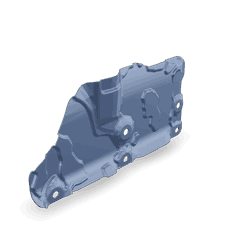This truck part is made by Cummins®. We guarantee that all of our parts are from the OEM (original equipment manufacturer), ensuring a proper fit and quality manufacturing.
We honor the warranty provided by the original equipment manufacturer.
Introduction
The Cummins 3689558 Heat Shield is a component designed to manage and mitigate the high temperatures generated within a truck’s engine compartment. Its role is to protect surrounding components from excessive heat, ensuring the longevity and efficiency of the engine system. In commercial truck operations, where engines are subjected to prolonged use and high loads, this part plays a significant role in maintaining optimal engine performance and safety 1.
Purpose and Function
The primary purpose of the heat shield in a truck’s engine compartment is to redirect and dissipate heat away from sensitive components. By doing so, it helps maintain a stable operating temperature for the engine and its surrounding parts. The heat shield operates by absorbing heat from hot surfaces and redirecting it away, thus preventing heat buildup that could lead to component failure or reduced efficiency 2.
Key Features
The Cummins 3689558 is constructed using high-quality materials that are resistant to heat and corrosion. Its design includes strategic placement and shaping to maximize heat dissipation and protection. Unique characteristics such as a durable coating and precise engineering enhance its performance, ensuring it can withstand the demanding conditions of commercial truck operations 3.
Benefits
The installation of the Cummins 3689558 offers several benefits. It contributes to improved engine longevity by protecting components from thermal stress. Enhanced safety is another advantage, as it reduces the risk of heat-related failures. Additionally, by maintaining optimal operating temperatures, the heat shield can contribute to potential fuel efficiency gains, as components operate more efficiently under controlled thermal conditions 4.
Installation Considerations
Proper installation of the heat shield is crucial for its effectiveness. It is important to follow manufacturer guidelines for placement and securing the shield to ensure it functions as intended. Special tools may be required for installation, and correct placement is vital for optimal performance. Ensuring that the heat shield is properly aligned and secured will help achieve the desired heat management and protection for the engine components.
Maintenance and Troubleshooting
Routine maintenance checks for the heat shield should include inspecting for signs of wear, corrosion, or damage. Ensuring that the shield remains securely in place and is free from obstructions is important for its continued effectiveness. Common issues may include displacement or damage to the shield, which can be addressed by resecuring or replacing the affected part as necessary.
Compatibility and Usage
The Cummins 3689558 is designed for use in specific types of trucks and engine configurations. It is particularly beneficial in environments where engines are exposed to high temperatures and prolonged operation, such as in heavy-duty trucking applications. Understanding the specific operational conditions and environments where this heat shield is most effective can help in selecting the appropriate component for a given application.
Manufacturer Overview
Cummins Inc. is a leading manufacturer of diesel engines, with a long history of innovation and expertise in the field. Their commitment to producing high-quality aftermarket parts, including the Cummins 3689558, reflects their dedication to enhancing the performance and reliability of commercial vehicles. Cummins’ extensive experience in engine manufacturing ensures that their aftermarket parts are designed with precision and reliability in mind, providing valuable solutions for maintaining and upgrading truck engines.
Role of 3689558 Heat Shield in Engine Systems
The 3689558 Heat Shield is an essential component in managing thermal conditions within engine systems, particularly when integrated with a turbocharger. When a turbocharger is in operation, it compresses the intake air, which significantly raises the temperature of the exhaust gases. These high temperatures can lead to heat transfer to nearby components, potentially causing damage or reducing efficiency. The heat shield, positioned strategically around the turbocharger and its associated piping, acts as a barrier to this heat. It reflects a substantial portion of the radiant heat away from sensitive components, such as the intercooler, intake manifold, and various wiring harnesses. This not only protects these parts from thermal stress but also helps maintain optimal operating temperatures for the turbocharger itself. Additionally, the heat shield assists in stabilizing the temperature of the air entering the intercooler. By reducing the heat soak from the turbocharger, the air remains cooler, which enhances its density. This, in turn, allows the turbocharger to compress the air more effectively, leading to improved engine performance and efficiency.
Conclusion
The Cummins 3689558 Heat Shield is a vital component in the thermal management of truck engines, offering protection to sensitive components from excessive heat. Its strategic placement and design ensure optimal engine performance and longevity. Proper installation, maintenance, and understanding of its compatibility and usage are crucial for maximizing its benefits in commercial truck operations.
-
Reif, Konrad. Fundamentals of Automotive and Engine Technology: Standard Drives, Hybrid Drives, Brakes, Safety Systems. Springer Vieweg, 2014.
↩ -
Ribbens, William B. Understanding Automotive Electronics. Elsevier Science, 2003.
↩ -
Taghavifar, Hamid, and Aref Mardani. Offroad Vehicle Dynamics Analysis Modelling and Optimization. Springer, 2017.
↩ -
Nunney, MJ. Light and Heavy Vehicle Technology, Fourth Edition. Butterworth-Heinemann, 2007.
↩
SPECIFICATIONS
RECOMMENDED PARTS
* Variable geometry turbocharger and electronic actuator repairs are not eligible to be claimed as over-the-counter under New or ReCon parts warranty for parts installed after October 1, 2018.
* Diesel Oxidation Catalyst (DOC), Diesel Particulate Filter (DPF), Selective Catalyst Reduction (SCR) catalyst, and Electronic Control Module (ECM) repairs are not eligible to be claimed as over-the-counter under New or ReCon parts warranty for parts installed after January 1, 2020.
* These restrictions are only applicable to New parts and ReCon parts coverages for the components listed above sold to a customer in the US or Canada. All other coverages are excluded. All other regions are excluded.









